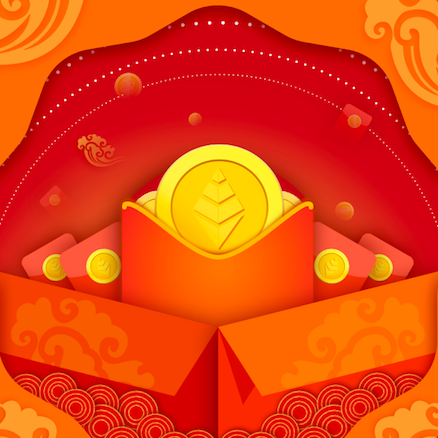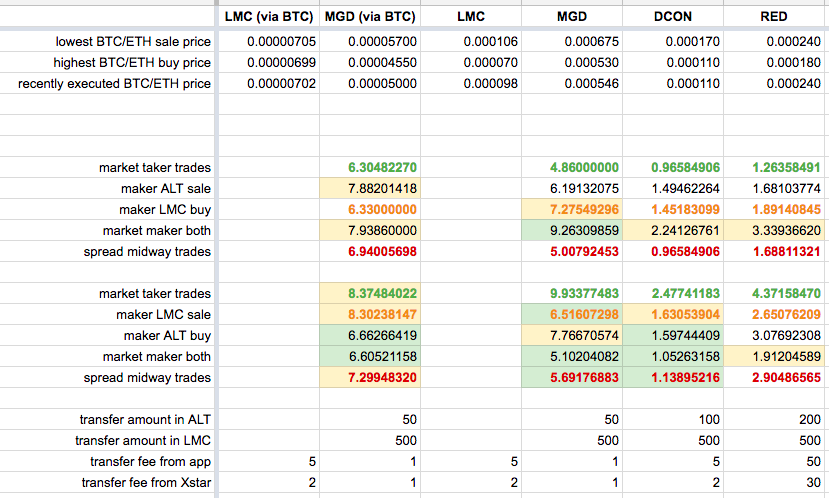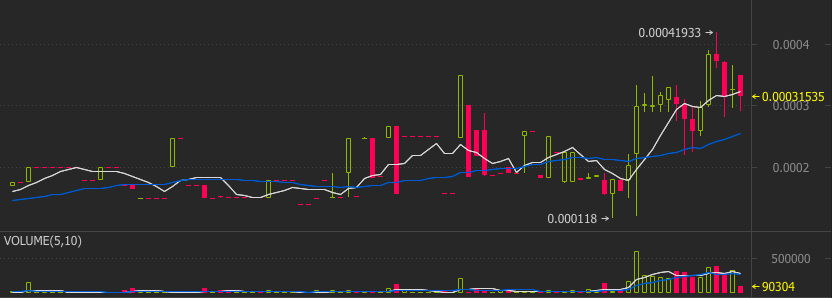LoMoStar: a world of opportunities and RED envelopes
I've been having a lot of fun with LoMoStar recently, a cryptocurrency mobile app that is in essence a powerful advertising platform. Its mechanics are based around envelopes, inspired by the Chinese tradition of gifting red envelopes during New Year's and other celebrations. In LoMoStar, these red envelopes contain cryptocurrencies.

A red envelope with RED tokens inside
Anyone can drop an envelope with an image of their choice (like an advertisement) into the "world view", where it will be seen and opened by users of the app. You can then add anyone who's opened one of your envelopes into your chatroom, where you can engage with them, drop more envelopes, and encourage others to drop envelopes of their own.
LoMoStar has worked hard to foster a positive and sharing community, who are keen to share the cryptocurrencies they received among each other, and you can expect a great deal of engagement and feedback in a well-ran chatroom. Right now, the "advertisers" on the platform are limited to new crypto currencies and/or tokens. The dropped envelopes effectively function as an airdrop, and promote awareness, recognition, and investment into those projects. Future plans include allowing running an ICO on the (soon to be rebranded) LoMoCoin chain, and picking up envelopes by going to physical locations, encouraging patronage to businesses.
Until those plans come to fruition, the most exciting aspect of the LoMoStar app for me is the T2T trading platform. It works much like a regular exchange, and users can trade the various airdropped cryptocurrencies with each other, including exchanging them for more established currencies such as LoMoStar's own LoMoCoin (LMC), as well as ETH, BTC, and USDT.

A view of the current bids for the RED token in T2T, including one of mine.
I wonder how many people noticed what makes the price of 3.14159265 so special :)
There's a unique aspect to it, in that any posted bid or ask must wait for approval from its poster before it can be executed. So one must be careful not to rely on offers that look too good to be true, because the poster may realise their mistake and reject the trade request. I won't comment on the pros and cons of this approach, except to say that it's refreshingly different, and encourages more careful planning of trading strategies, as well as opening up a world of new strategies.
Some tales of arbitrage
Since the T2T trading function opened, I have managed to turn 250 LMC that I purchased on Bittrex into 3,000 LMC, mostly via simple arbitrage. Especially when the function was first introduced, there was a bit of chaos as the process of price discovery was taking place, and coins could be snapped up far below their market value. I took advantage of this to buy the discounted coins and sell them on XStar, an exchange ran by LoMoStar. Soon, however, the buy orders on XStar got eaten through and this stopped being profitable.
But as the price discovery process continued, the opposite became profitable: buying on XStar and selling on the LoMoStar app. This was of course more risky, since there was no guarantee that the buy offers in T2T would be accepted, but I still managed to make a fair bit of profit doing that. Eventually, price discovery in the app reached an equilibrium with outside exchanges, and that avenue was exhausted as well.

The spreadsheet I used to keep track of opportunities for arbitrage. The top and bottom set of coloured rows are equivalent prices on XStar in LMC for selling and buying the tokens respectively, after accounting for transfer fees to/from the app. The colours indicate whether I could trade them at a profitable price in the app as a market maker (yellow) or taker (green).
One of the main factors that brought about the equilibrium was the introduction of "floating prices". This new functionality allowed T2T users to post orders at a set percentage premium from the market price. Incidentally, this increased awareness of the market price for the users, so the price discrepancies all but disappeared. However, the market prices fetched by the system were not always representative for very low-volume coins.
Bitcoin Token (BTK) was one such coin with incredibly low volume, so its market price represented the price of the last executed trade, not accounting for the fact that the actual ask and bid prices had moved downwards significantly since that trade. Noticing this, I quickly snapped up a large amount of BTK on ForkDelta, sent it into the app, and managed to sell it all right before the floating pice in the app dropped to the "correct" levels. This was profitable even though I had to go through the process of transferring my LMC to Bittrex, selling it for BTC, using it to buy ETH, sending it to ForkDelta, buying the BTK, and sending it into the app, incurring fees at each of those steps. I had of course accounted for those fees in my calculations.
Another opportunity was presented by a project called Cybereits (CRE). CRE had been trading on the BigONE exchange for a while even before being airdropped into LoMoStar, but withdrawals had not yet been enabled within the app. Perhaps because of that, which made people think that selling CRE on T2T was their only option, or perhaps because floating prices hadn't been introduced yet, it was trading at a huge discount on T2T. I bought up as much as I could and waited patiently for withdrawals to be enabled. The moment it happened, I was able to send my BTK to BigONE, sell it for BTC, use it to buy LTC, send it to Bittrex, sell it for BTC, buy LMC with it, and send it back to the app. Despite the sheer number of steps and fees, including the large fee for sending ERC20 tokens out of the LoMoStar app, that was still highly profitable. Incidentally, almost immediately after withdrawals of CRE were enabled, the trading price adjusted itself into an equilibrium with BigONE. My guess is that I wasn't the only one who had done the calculations involved.
The Red Community Token
The project I'm currently looking at as my next profit opportunity is the Red Community Token (RED). It's quite an interesting project, and is the only one out of all the coins on LoMoStar that I decided to keep (or HODL, if you will) a fair amount of in my personal wallet.
Red is a programming language that started development in 2011, designed to improve on the Rebol language it's based on. It aims to be a "full-stack" language, producing small (1MB) self-contained apps that can run across a wide variety of operating systems and platforms, without relying on external dependencies. The full stack includes the graphical user interface all the way down to low-level system calls, all in that tiny package. it's one of those things where as a software developer, you think: that's really cool, I don't know if I'm going to end up using it, but I really like that people are working on things like this. I often rely on comments on Hacker News to provide informed insight on new developments, and whenever an article on Red has been posted there, the responses have been overwhelmingly positive[1][2][3].
Until last year, the Red project had been relying on donations and community contributions to continue development, and increasingly struggled to sustain itself. However, as blockchain entered the mainstream, the developers realised that it not only provided a unique funding opportunity, but that blockchain support is something a project like theirs should strive for. To quote a comment on their ICO announcement: "Red's goal is to be a full-stack language. Blockchain is a part of the full stack."

The Red language logo gains another layer on its "stack" as it becomes the RED token logo.
So they announced the development of Red/C3, a dialect of Red that could be used for programming smart contracts on the blockchain. The Red Foundation was founded to oversee future Red development, supported by the Red Community Tokens issued via their ICO. The tokens would initially be used to reward contributors and grant voting rights, then expanded for use in distributed applications (DApps) built using Red/C3, with the future possibility of powering Red's own blockchain.
Oftentimes I hear people ask: does this project need the blockchain? To that, I respond with two questions of my own: is this a project that should exist and will make the world a better place? And: would this project exist without the funding opportunities offered by the blockchain? When the answer to the former is yes, and the answer to the latter is no (as I think is the case here), then the project does need the blockchain. Without it, it wouldn't be able to exist. I know this isn't a common or popular way to look at things, but I think the logic is sound, and I stand by it.
Being such a niche project, Red has struggled to get a listing on major exchanges, trading only on XStar and KKCoin so far. However, on the 3rd of May, it managed to make it to the listing vote on Bibox, one of the top 20 exchanges by volume. In a true testament to the size and dedication of the community behind Red, it won the vote, and will be listed on Bibox this week.
New exchange listings almost always result in a significant price jump, so as soon as I heard the results of the vote, I jumped onto T2T to buy up as much Red as I could. Since T2T prices are slow to adjust to new price developments, I was able to accumulate a fair bit of it at a great price. The price on KKCoin has already shot up in reaction to the news, and I could sell now for a fair profit. But I'd rather not sign up for yet another exchange, and I'm happy to take my chances with whatever price it ends up going for on Bibox.

Big increases in both price and volume on KKCoin as the Bibox listing looms.
Of course, I will be converting my profits right back to LMC and sending them back to the app, to be ready for any new opportunities that come up. Or, since LMC supports staking, I might keep them in a wallet for some passive income.
Some final words
Overall, I'm a big fan of LoMoStar. I see great potential in it as an advertising platform. Opening the colourful envelopes and watching numbers go up also provide the kind of little dopamine bursts that can make it very addicting, which bodes well for user engagement and retention. And of course, there's the T2T platform. Even though the profits I made from it aren't very large in absolute terms (though they're quite large in percentage terms), I've found that it has incredible value as a learning tool. If you're new to trading and crypto, it offers great opportunities to learn how markets work without having too much at stake. Those lessons can then be used for profits at a larger scale elsewhere in the market.
If you're intrigued, the LoMoStar app can be downloaded here. And of course, I'd appreciate it if you used my referral code when you sign up: 15G4nZ
Of the tokens mentioned here, I have holdings in LMC and RED.
Great article Scopia. Very interesting seeing your insights and strategies to take advantage of the market, especially new markets, inefficiencies. It will be interesting to see how much more will be possible with internal in-app ICO buys and how they will effect the t2t and other markets. Thanks much!
Amazing article @cryptoscopia! Truly enlightening on how we can exploit the T2T feature for profit! I now need to bag in your tips and finally start doing good LoMoStar app trades of my own. :-)
Coins mentioned in post:
Congratulations @cryptoscopia! You have completed some achievement on Steemit and have been rewarded with new badge(s) :
Click on the badge to view your Board of Honor.
If you no longer want to receive notifications, reply to this comment with the word
STOPCongratulations @cryptoscopia! You received a personal award!
Click here to view your Board
Congratulations @cryptoscopia! You received a personal award!
You can view your badges on your Steem Board and compare to others on the Steem Ranking
Vote for @Steemitboard as a witness to get one more award and increased upvotes!